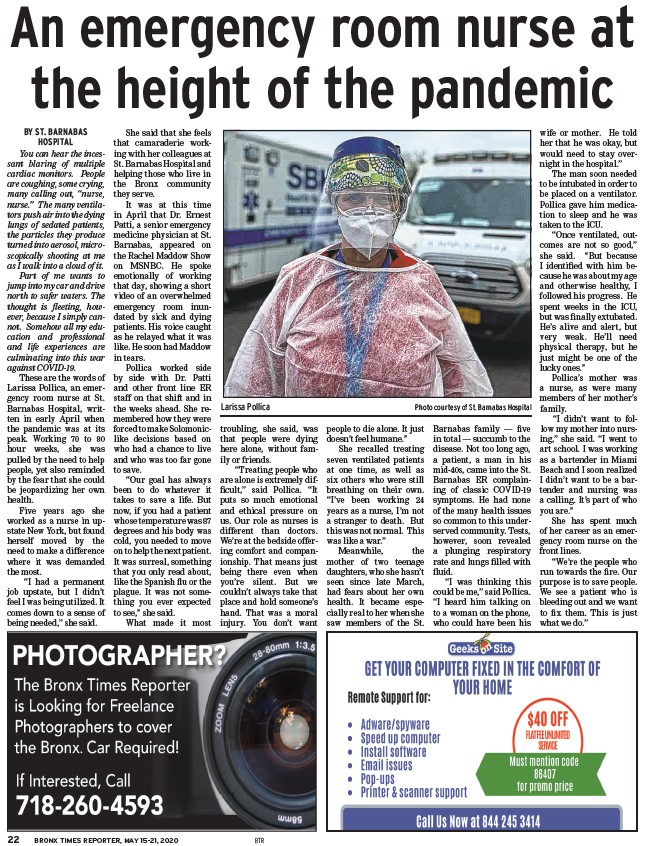
An emergency room nurse at
the height of the pandemic
BY ST. BARNABAS
HOSPITAL
You can hear the incessant
blaring of multiple
cardiac monitors. People
are coughing, some crying,
many calling out, “nurse,
nurse.” The many ventilators
push air into the dying
lungs of sedated patients,
the particles they produce
turned into aerosol, microscopically
shooting at me
as I walk into a cloud of it.
Part of me wants to
jump into my car and drive
north to safer waters. The
thought is fl eeting, however,
because I simply cannot.
Somehow all my education
and professional
and life experiences are
culminating into this war
against COVID-19.
These are the words of
Larissa Pollica, an emergency
room nurse at St.
Barnabas Hospital, written
in early April when
the pandemic was at its
peak. Working 70 to 80
hour weeks, she was
pulled by the need to help
people, yet also reminded
by the fear that she could
be jeopardizing her own
health.
Five years ago she
worked as a nurse in upstate
New York, but found
herself moved by the
need to make a difference
where it was demanded
the most.
“I had a permanent
job upstate, but I didn’t
feel I was being utilized. It
comes down to a sense of
being needed,” she said.
She said that she feels
that camaraderie working
with her colleagues at
St. Barnabas Hospital and
helping those who live in
the Bronx community
they serve.
It was at this time
in April that Dr. Ernest
Patti, a senior emergency
medicine physician at St.
Barnabas, appeared on
the Rachel Maddow Show
on MSNBC. He spoke
emotionally of working
that day, showing a short
video of an overwhelmed
emergency room inundated
by sick and dying
patients. His voice caught
as he relayed what it was
like. He soon had Maddow
in tears.
Pollica worked side
by side with Dr. Patti
and other front line ER
staff on that shift and in
the weeks ahead. She remembered
how they were
forced to make Solomoniclike
decisions based on
who had a chance to live
and who was too far gone
to save.
“Our goal has always
been to do whatever it
takes to save a life. But
now, if you had a patient
whose temperature was 87
degrees and his body was
cold, you needed to move
on to help the next patient.
It was surreal, something
that you only read about,
like the Spanish fl u or the
plague. It was not something
you ever expected
to see,” she said.
What made it most
troubling, she said, was
that people were dying
here alone, without family
or friends.
“Treating people who
are alone is extremely diffi
cult,” said Pollica. “It
puts so much emotional
and ethical pressure on
us. Our role as nurses is
different than doctors.
We’re at the bedside offering
comfort and companionship.
That means just
being there even when
you’re silent. But we
couldn’t always take that
place and hold someone’s
hand. That was a moral
injury. You don’t want
BRONX TIMES R 22 EPORTER, MAY 15-21, 2020 BTR
people to die alone. It just
doesn’t feel humane.”
She recalled treating
seven ventilated patients
at one time, as well as
six others who were still
breathing on their own.
“I’ve been working 24
years as a nurse, I’m not
a stranger to death. But
this was not normal. This
was like a war.”
Meanwhile, the
mother of two teenage
daughters, who she hasn’t
seen since late March,
had fears about her own
health. It became especially
real to her when she
saw members of the St.
Barnabas family — fi ve
in total — succumb to the
disease. Not too long ago,
a patient, a man in his
mid-40s, came into the St.
Barnabas ER complaining
of classic COVID-19
symptoms. He had none
of the many health issues
so common to this underserved
community. Tests,
however, soon revealed
a plunging respiratory
rate and lungs fi lled with
fl uid.
“I was thinking this
could be me,” said Pollica.
“I heard him talking on
to a woman on the phone,
who could have been his
wife or mother. He told
her that he was okay, but
would need to stay overnight
in the hospital.”
The man soon needed
to be intubated in order to
be placed on a ventilator.
Pollica gave him medication
to sleep and he was
taken to the ICU.
“Once ventilated, outcomes
are not so good,”
she said. “But because
I identifi ed with him because
he was about my age
and otherwise healthy, I
followed his progress. He
spent weeks in the ICU,
but was fi nally extubated.
He’s alive and alert, but
very weak. He’ll need
physical therapy, but he
just might be one of the
lucky ones.”
Pollica’s mother was
a nurse, as were many
members of her mother’s
family.
“I didn’t want to follow
my mother into nursing,”
she said. “I went to
art school. I was working
as a bartender in Miami
Beach and I soon realized
I didn’t want to be a bartender
and nursing was
a calling. It’s part of who
you are.”
She has spent much
of her career as an emergency
room nurse on the
front lines.
“We’re the people who
run towards the fi re. Our
purpose is to save people.
We see a patient who is
bleeding out and we want
to fi x them. This is just
what we do.”
Larissa Pollica Photo courtesy of St. Barnabas Hospital